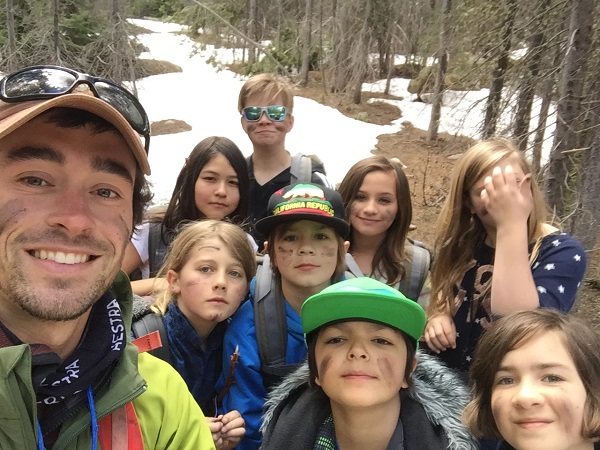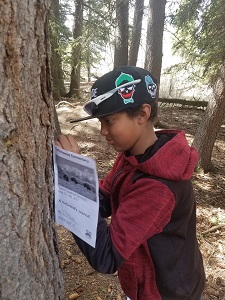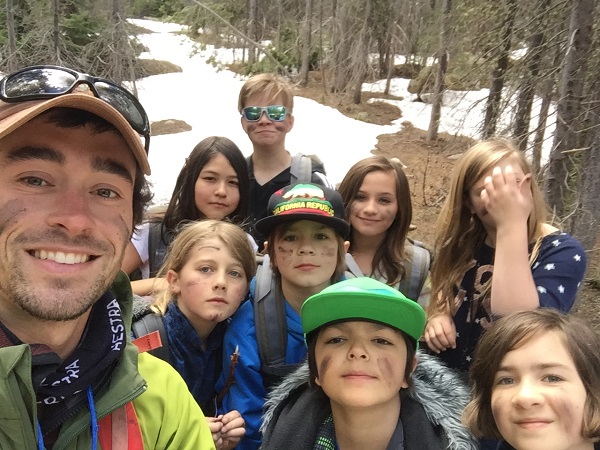
Editor’s Note: This fall, we say goodbye to two Lead Instructors who are leaving TSS for new adventures. We’re excited to share their reflections on their time with Field Education and are beyond grateful for the impact they’ve made, both in this community and in the lives of their many, many students. Best of luck with your next steps, Kelsie and Kyle, and thank you for sharing these parting thoughts.
Kelsie Leu – AmeriCorps Member, Instructor, Lead Instructor, AmeriCorps Program Assistant; Fall 2014 to Fall 2017
What is your favorite thing to teach here in the Greater Yellowstone Ecosystem (GYE), and why?
 I always loved teaching about the interconnectedness of an ecosystem by using real life issues happening in the GYE. One of my favorite lessons to lead was an evening program focused on discussing the status of wolves in the GYE.
I always loved teaching about the interconnectedness of an ecosystem by using real life issues happening in the GYE. One of my favorite lessons to lead was an evening program focused on discussing the status of wolves in the GYE.
What places, books, experiences, or people have most shaped you as a TSS field instructor?
This is difficult for me to pinpoint! I have found that I am challenged and growing the most as an educator when I am either working with other instructors on lessons they have taught or planning and co-teaching with AmeriCorps members. I’ve also learned so much [from folks] throughout the TSS community. I always felt that every person I worked with had something amazing to teach me.
What has been your greatest impact during your time at TSS?
 It has been great to reflect on the past three years and think about how much I have grown as an educator and leader. Something I hope to have impacted, and that also heavily impacted me, was working with all of the AmeriCorps members. Over the past few years, I learned and experienced how much that program brings to the entire Jackson community. I hope that I was able to use my ever-developing mentoring skills to not only learn from those individuals, but also to teach them about this place and about field education.
It has been great to reflect on the past three years and think about how much I have grown as an educator and leader. Something I hope to have impacted, and that also heavily impacted me, was working with all of the AmeriCorps members. Over the past few years, I learned and experienced how much that program brings to the entire Jackson community. I hope that I was able to use my ever-developing mentoring skills to not only learn from those individuals, but also to teach them about this place and about field education.
What do you hope your TSS legacy is?
I hope to have helped create a culture of collaboration within the Field Education team.
What’s next for you?
I will be the new Youth Program Manager at Montana Conservation Corps in Bozeman.
Kyle Kissock – AmeriCorps Member, Instructor, Lead Instructor; Summer 2014, Summer 2015, Summer 2016 through Fall 2017
What is your favorite thing to teach here in the GYE, and why?
 What’s been so nice about this job is that field instructors have the ability to teach pretty much whatever we are passionate about. It’s hard to believe I’ll ever be in another role where I’ll have this much freedom as an educator. Recently, it’s been the concept of what an ecosystem is. Understanding ecosystems, or just systems in general, is valuable for a million reasons, but I think for a lot of our students it can be grounding to realize that they are small parts of larger, more complicated wholes. Small changes to a system can have widespread repercussions. Being able to identify what cultural and ecological systems you are a part of, and how those systems change when tinkered with, is an important skill.
What’s been so nice about this job is that field instructors have the ability to teach pretty much whatever we are passionate about. It’s hard to believe I’ll ever be in another role where I’ll have this much freedom as an educator. Recently, it’s been the concept of what an ecosystem is. Understanding ecosystems, or just systems in general, is valuable for a million reasons, but I think for a lot of our students it can be grounding to realize that they are small parts of larger, more complicated wholes. Small changes to a system can have widespread repercussions. Being able to identify what cultural and ecological systems you are a part of, and how those systems change when tinkered with, is an important skill.
What places, books, experiences, or people have most shaped you as a TSS field instructor?
Books: David Quammen’s writings in the 2016 National Geographic, Yellowstone edition, are my bible. I’d also recommend the yearly Yellowstone Resources and Issues Handbook to any visitor to the Greater Yellowstone Ecosystem.
People: Matthew McGee, former Graduate Faculty, for taking us into the field to teach us something new every time we taught with him. Tanya Anderson, Field Education Faculty, for trusting me. Christen Girard, Field Education Faculty, for her mentorship. And the Field Education instructor team, past and present, for all the wonderful memories.
 Experiences: Seeing my first grizzly bear, at dawn on Dunraven Pass; journaling with 5th graders at sunset on the shore of Yellowstone Lake; hanging on to every last word of Rick Mcyntrye’s wolf stories, and getting to teach wolf reintroduction myself in the Lamar Valley; being in the snow with kids who have never seen snow before; moon-lit winter skis at the Kelly Campus; whiteout ski conditions on the Park Road; surprise hot chocolate for the best field groups; a detour through Bozeman when a fall snowstorm trapped us in Mammoth; and two trips to Pinedale to pull old barbwire to create wildlife habitat. These and so many more.
Experiences: Seeing my first grizzly bear, at dawn on Dunraven Pass; journaling with 5th graders at sunset on the shore of Yellowstone Lake; hanging on to every last word of Rick Mcyntrye’s wolf stories, and getting to teach wolf reintroduction myself in the Lamar Valley; being in the snow with kids who have never seen snow before; moon-lit winter skis at the Kelly Campus; whiteout ski conditions on the Park Road; surprise hot chocolate for the best field groups; a detour through Bozeman when a fall snowstorm trapped us in Mammoth; and two trips to Pinedale to pull old barbwire to create wildlife habitat. These and so many more.
What has been your greatest impact during your time at TSS?
I hope it’s been teaching transference [back to students’ home communities]. It is easy to fall in love with the outdoors in Jackson Hole, in part because the ecological patterns and connections that make this place feel unique are relatively obvious. If you’re a student coming from a suburb of St. Louis or Houston, connections with the natural world at home might be more subtle. Your place might feel less special than Jackson, even though it isn’t. If my students go home and tell their families, “the Tetons was the best trip ever!” that’s a start, but what I really hope is that something they learned here in the Tetons sparks a curiosity that they take home and act upon.
 What do you hope your TSS legacy is?
What do you hope your TSS legacy is?
I don’t know that I have a personal legacy, but I do hope the instructor team never stops wanting to learn about this place. If you’ve been with me in the field, you know my passions are birding and geology. I’ve also become a huge phenology nerd and can return to the same trail week after week and find new excitement in the seasonal transformations taking place. This excitement has grown richer the longer I’ve been here and the more I’ve learned from others in this community. My hope is that TSS instructors, in the midst of new, exciting curricular changes, never forget to be scientists and science students themselves. My biggest regret is that it took until now for me to start keeping a field journal … Hey instructors, keep a field journal!
What’s next for you?
I’ll be staying in the area to work the winter for the Grand Teton Association and the National Park Service as an education associate.


